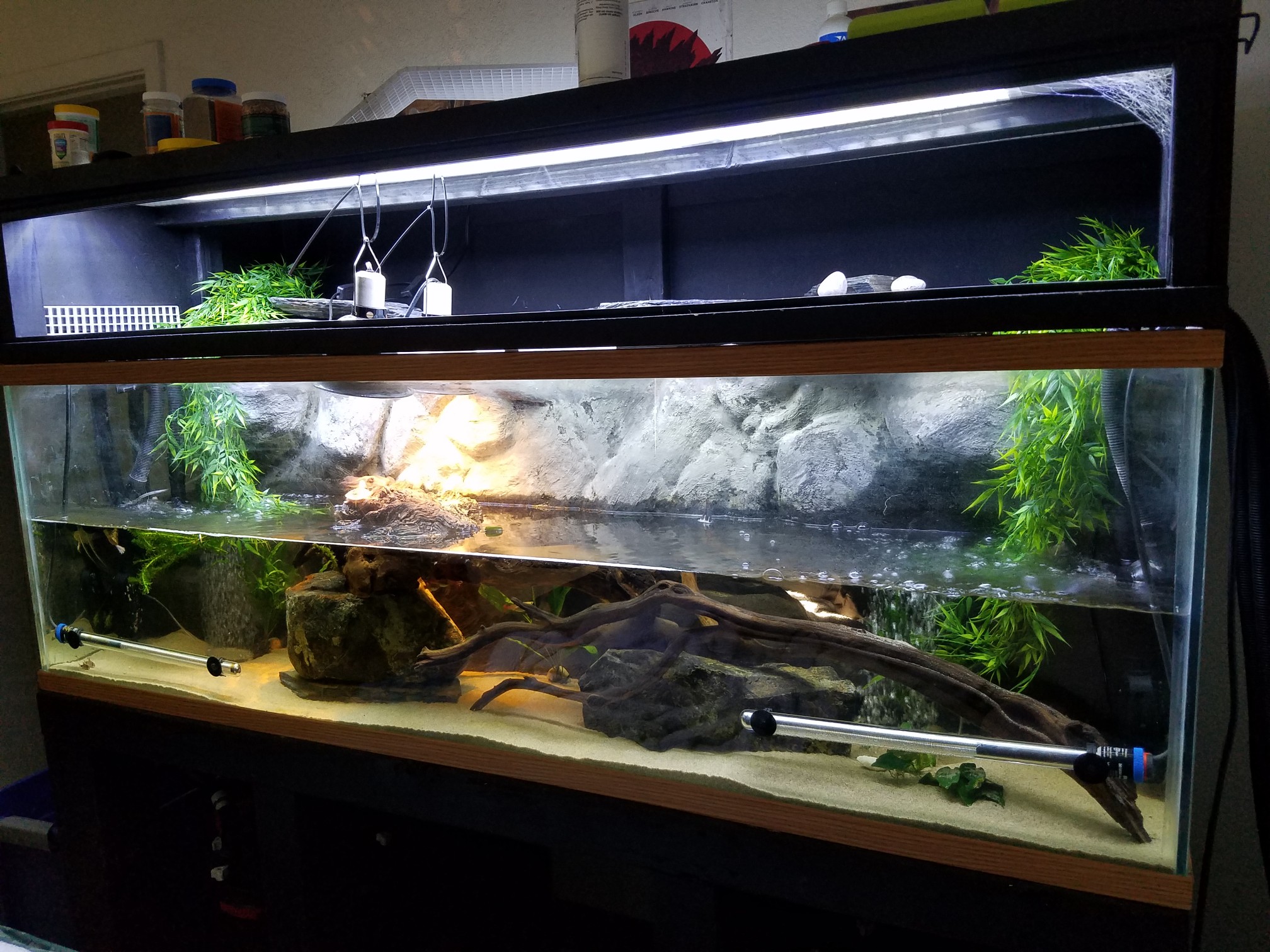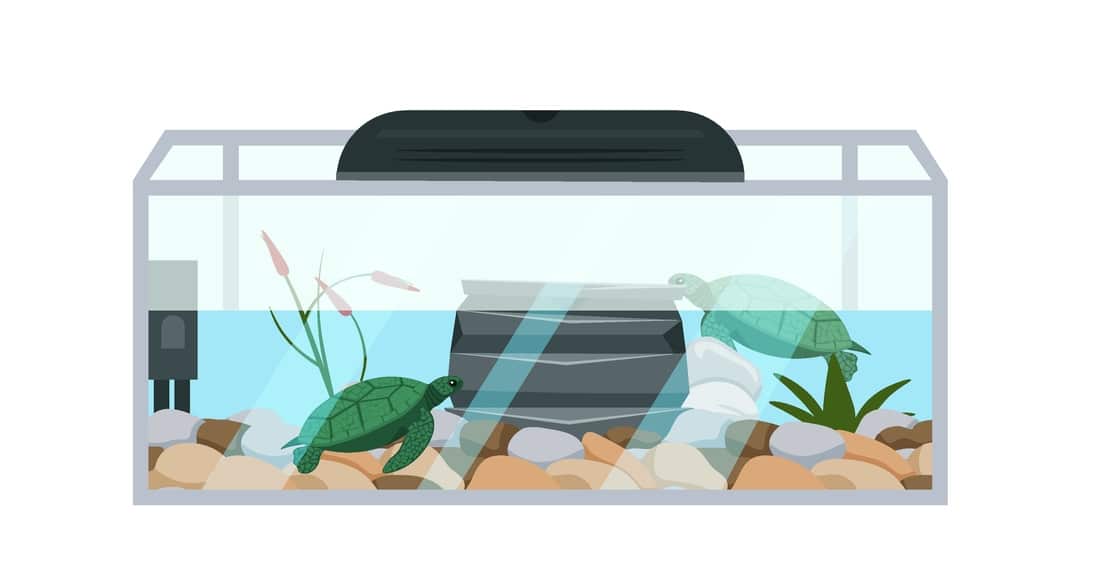To set up a perfect aquarium for your pet turtle, you need a large tank with a basking area and uvb lighting. Keeping a pet turtle is a rewarding experience, but setting up the perfect aquarium for your shelled friend can be a daunting task.
It’s crucial to give your turtle a comfortable habitat that replicates its natural environment. In this guide, we’ll discuss the importance of choosing the right tank, creating a basking area, installing a filtration system, and much more. We’ll also provide some tips on selecting the best plants and substrate to keep your aquarium clean and healthy for your pet turtle.
Follow this guide, and you’ll have a thriving turtle and an attractive aquarium that will enhance any living space.

Credit: reptifiles.com
Choosing The Right Aquarium
Creating the ultimate turtle environment requires a lot of effort, and one of the most important aspects is choosing the right aquarium. Here are some tips you should consider before selecting an aquarium for your turtle:
Size Requirements For Different Species Of Turtles
Different species of turtles have different size requirements, which means you need to choose an aquarium according to the needs of your turtle. Here are some general guidelines:
- A 40-gallon aquarium is suitable for small turtles such as the eastern painted turtle or the musk turtle.
- Medium-sized turtles like the red-eared slider and box turtles require at least a 75-gallon aquarium.
- Larger turtles like the common snapping turtle need a minimum of 125 gallons.
Glass Vs. Acrylic Aquariums
When it comes to aquariums, you have two main options: glass and acrylic. Each has its own advantages and disadvantages. Here are some things to consider while choosing between them:
Glass aquariums:
- They are less expensive than acrylic aquariums.
- They are less prone to scratches than acrylic aquariums.
- They are heavier and less likely to tip over.
Acrylic aquariums:
- They are more expensive than glass aquariums.
- They are lighter than glass aquariums, making them easier to move.
- They are more prone to scratches than glass aquariums.
Filter And Lighting Options
Once you have selected the right aquarium, you need to think about filter and lighting options. Here are some things you should keep in mind:
Filter options:
- A canister filter or a hang-on-back filter can be suitable for most turtle aquariums.
- Choose a filter that is appropriate for the size of your aquarium.
- Make sure to clean the filter regularly.
Lighting options:
- Turtles require uvb light to stay healthy.
- You can get special uvb bulbs for aquariums that are designed specifically for turtles.
- Use a timer to ensure that your turtle is getting the required amount of light per day.
Choosing the right aquarium is crucial for creating a healthy and happy environment for your turtle. Make sure to consider the size requirements of your turtle, the material of the aquarium, and the filter and lighting options before making a final decision.
Setting Up The Aquarium
Step-By-Step Guide To Setting Up The Aquarium
Creating a comfortable and healthy environment for turtles is vital to their well-being. The first step in doing so is preparing the aquarium. Here’s how you can set up the perfect turtle habitat:
- Choose the right size: Consider the size and species of your turtle while purchasing the aquarium. A general rule of thumb is to provide ten gallons of water for every one inch of the turtle’s shell length.
- Select a filter: Invest in a high-quality filter that can handle at least twice the capacity of your tank size. A properly functioning filter will maintain water quality and keep your turtle healthy.
- Add a basking platform: Turtles need a spot to relax out of the water and bask in the sun. You can create a platform with rocks, driftwood, or purchase a ready-made dock.
Adding Decor And Substrate
- Choose the right substrate: Gravel, sand, or large rocks, all make comfortable substrates for turtles. Ensure that the substrate does not harm your turtle, and replace it routinely to maintain cleanliness.
- Decorate the aquarium: Turtles love hiding places and plants. Create an ideal habitat by adding rocks and caves for hiding and basking spots.
Water Chemistry And Temperature Regulation
- Maintain proper water chemistry: Turtles need clean and chemically balanced water. Make sure to replace at least 25 percent of the water every week.
- Control the temperature: Turtles require a specific temperature range to stay healthy; typically, between 75-80º fahrenheit. Invest in a heater and thermometer to monitor the temperature and keep it within the optimal range.
By following these simple steps, you can create an ideal environment for your turtle to thrive in.
Choosing The Right Turtles
Explanation Of Different Species And Their Habitat Requirements
When it comes to choosing the right turtles for your aquarium, it’s crucial to understand the different species and their specific habitat requirements. Here are some of the most common types of turtles you may consider for your aquarium:
- Red-eared slider: A popular species for aquariums, red-eared sliders require ample space to swim around. They prefer a basking area with access to uvb lighting, and a water temperature range of 75-80 degrees fahrenheit.
- Painted turtle: Painted turtles are another common species kept in aquariums. They need a large swimming area, a basking area with access to uvb lighting, and a water temperature range of 75-80 degrees fahrenheit.
- Map turtle: Map turtles require similar habitat requirements as red-eared sliders and painted turtles. They prefer a water temperature range of 72-78 degrees fahrenheit and access to a basking area with uvb lighting.
Compatibility Between Different Species
It’s essential to consider compatibility when selecting turtles for your aquarium. Some species may not get along well with others, leading to aggression or stress. Here are some factors to consider to ensure compatibility:
- Size: Avoid keeping turtles of vastly different sizes together, as larger turtles may become aggressive and harm smaller ones.
- Species: Some species of turtles are more aggressive than others. Avoid keeping aggressive and passive species in the same aquarium.
- Gender: Keeping turtles of the same gender is usually best, as males may become territorial and compete for female attention.
Where To Purchase Turtles
When it comes to purchasing turtles for your aquarium, it’s crucial to buy from a reputable source. Here are some options to consider:
- Pet stores: Many pet stores sell turtles, but be sure to research the store’s reputation and ensure they’re reputable and knowledgeable about turtle care.
- Online retailers: Online retailers such as amazon and chewy sell turtles, but it’s essential to order from a reputable seller with good reviews and a focus on proper animal care.
- Breeders: Some breeders specialize in breeding and selling turtles. Purchasing from a reputable breeder ensures that the turtles are healthy and well-raised.
Keep in mind that many species of turtles are protected by law, and it’s illegal to buy or sell them without the proper permits. Be sure to research the laws in your area before purchasing a turtle for your aquarium.
By following these tips when selecting turtles for your aquarium, you’ll be able to create the ultimate turtle environment and provide your new pets with a healthy and happy home.
Feeding And Caring For Your Turtles
You have set up your turtle’s aquarium, and your little buddies have settled in wonderfully. Now it’s time to turn your attention to their feeding and general well-being. Here are some tips for keeping your turtles healthy:
What To Feed Your Turtles
Turtles are omnivores and require a balanced diet of both animal and plant-based foods. There are several options you can consider:
- Commercial turtle food: You can choose from a variety of commercial turtle foods available in the market. Make sure to look for those that contain 30% protein and 5% fat, and the ingredients list includes whole meats and vegetables.
- Vegetables: Your turtle will love a variety of vegetables such as kale, cucumber, carrots, squash, and sweet potato. Always ensure to chop them into small pieces so that your turtle can easily chew and digest them.
- Live food: Offer live insects as a treat for your turtle, such as earthworms, crickets, and mealworms. Ensure the insects you feed are not contaminated by pesticides or caught from the wild.
How Often To Feed
You should feed your turtle on a consistent schedule for the best results.
- Young turtles aged 0-12 months need to be fed daily, while adult turtles should be fed every other day.
- Offer a small amount of food each time you feed; adult turtles only need a feeding amount equal to about the size of their head.
Tips For Keeping Your Turtles Healthy
- Make sure that your turtles have access to clean water at all times. Change their aquarium’s water a few times a week.
- Scrub the turtle’s food and water bowls after each use to avoid any bacterial or fungal infections.
- Regularly check your turtle’s shell for any signs of damage or cracks.
- Monitor your turtle’s behavior and appetite regularly. If there are any sudden changes, it is best to contact a veterinarian.
By following these simple tips, you can ensure that your turtles live a happy and healthy life in their aquarium!
Frequently Asked Questions On How To Set Up The Perfect Aquarium For Your Pet Turtle
How Much Water Should I Put In The Aquarium For My Pet Turtle?
The amount of water in your pet turtle’s aquarium should be at least 10 gallons of water for every inch of your turtle’s shell length.
Can I Use Tap Water For My Pet Turtle’S Aquarium?
You can use tap water, but it needs to be free of chlorine and other harmful chemicals. The water can be dechlorinated by using specific chemicals or leaving it standing for approximately ten days.
What Kind Of Lights Should I Use For My Pet Turtle’S Aquarium?
You should install uvb lights for your pet turtle’s aquarium. Uvb lights help to regulate the turtle’s metabolism, ensure proper shell growth and melanin regulation.
Should I Add A Heater To My Pet Turtle’S Aquarium?
Yes, you need to add a heater to your pet turtle’s aquarium because turtles like warm water of around 75-85° f. a thermometer should also be installed to monitor the water temperature.
How Often Should I Clean My Pet Turtle’S Aquarium?
You should clean your pet turtle’s aquarium once a week. This involves changing 25-50% of the aquarium’s water, cleaning the filter, and scrubbing off any algae build-up on the tank walls.
Conclusion
A turtle can be an excellent pet to have in your home, and setting up the right aquarium for them is crucial for their health. Remember that every species of turtle has unique needs and it’s essential to do your research before buying or adopting.
Make sure that the aquarium you choose is the right size and has all the necessary equipment, including a filter and appropriate lighting. Keep the temperature at the right level, so your turtle stays happy and healthy. You should also provide a balanced diet and clean the tank regularly.
Always keep an eye on your turtle’s behavior and make adjustments to the tank as necessary. By following these tips, you can set up the perfect home for your pet turtle, providing a long and happy life for your shelled friend.





Leave a Reply